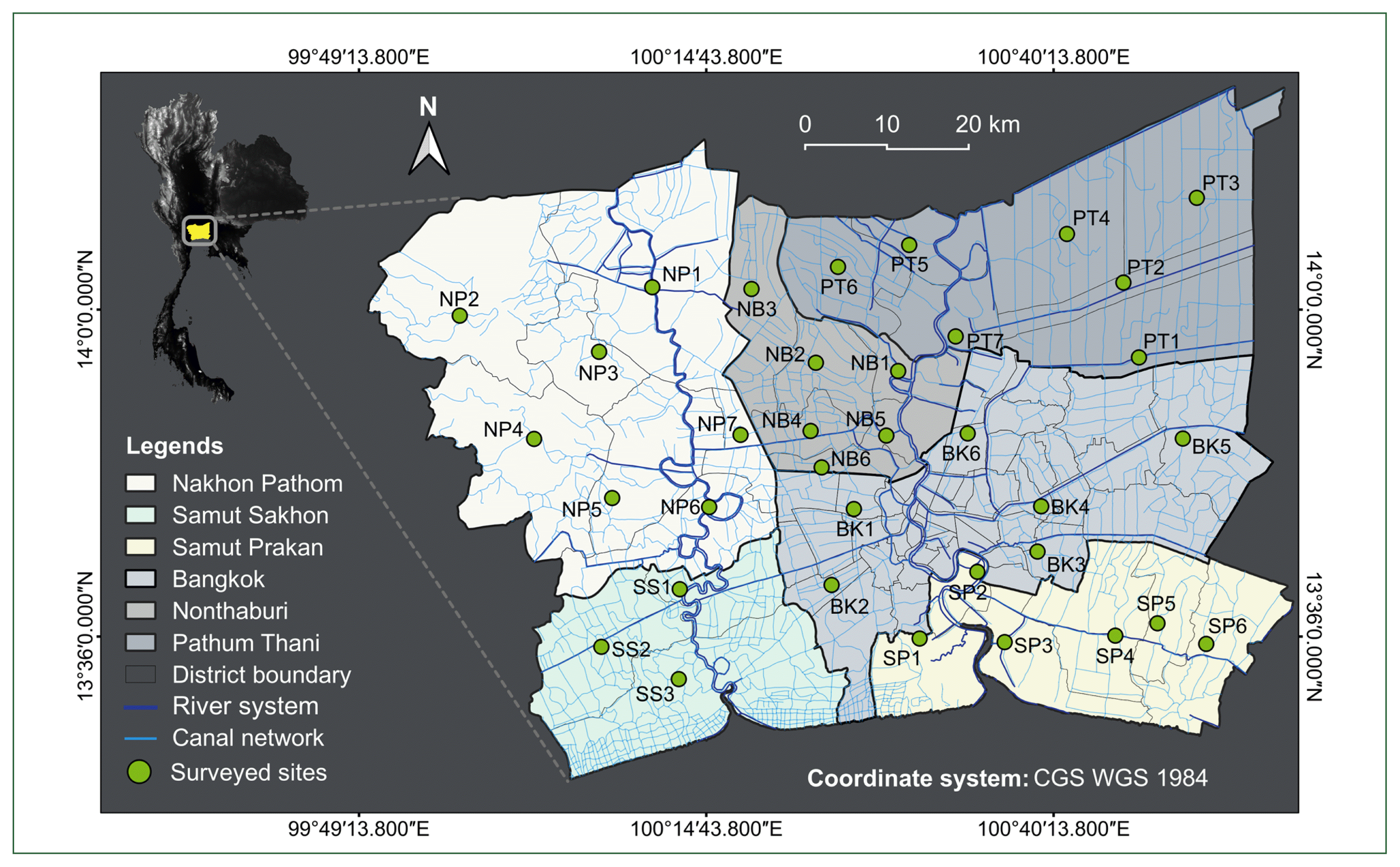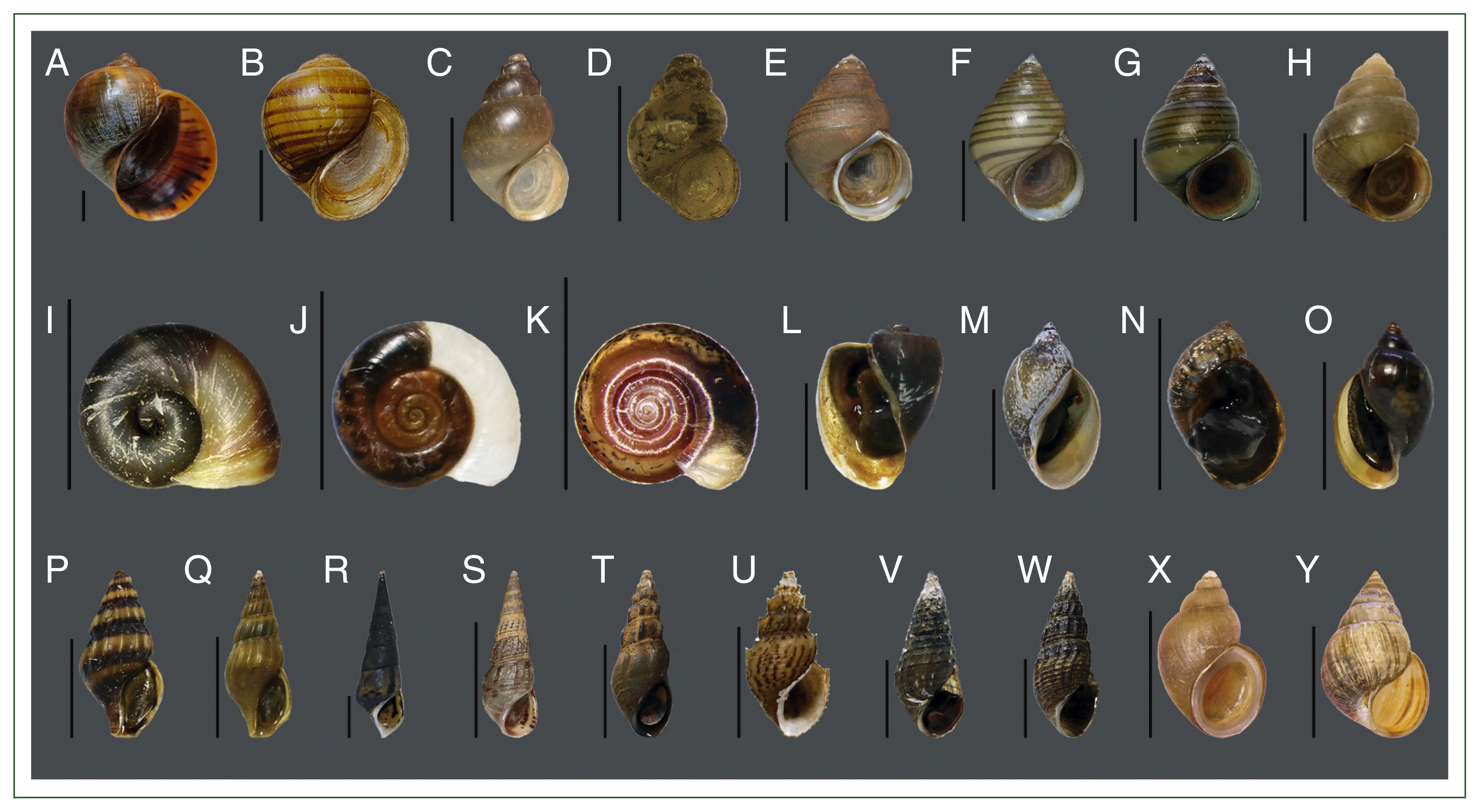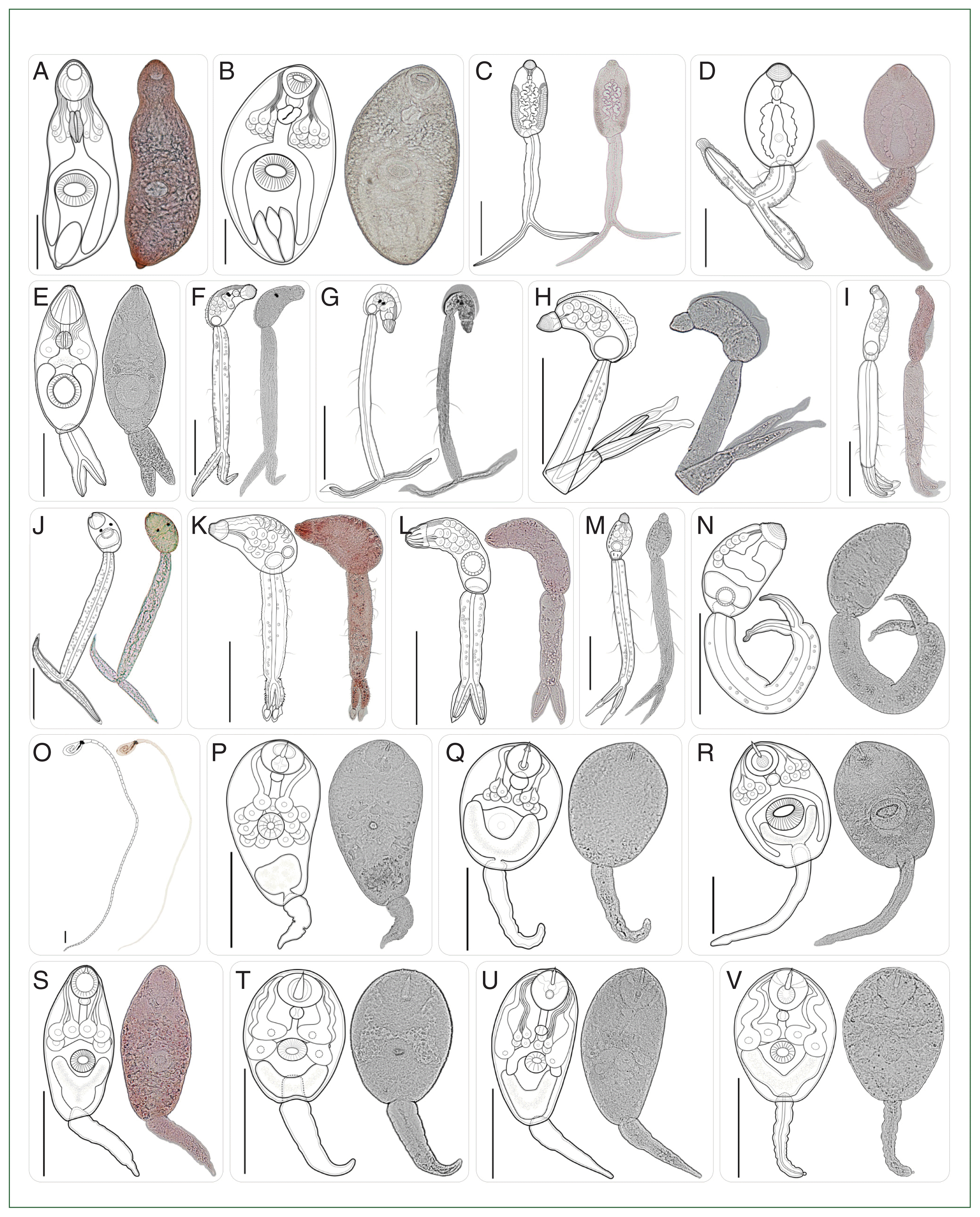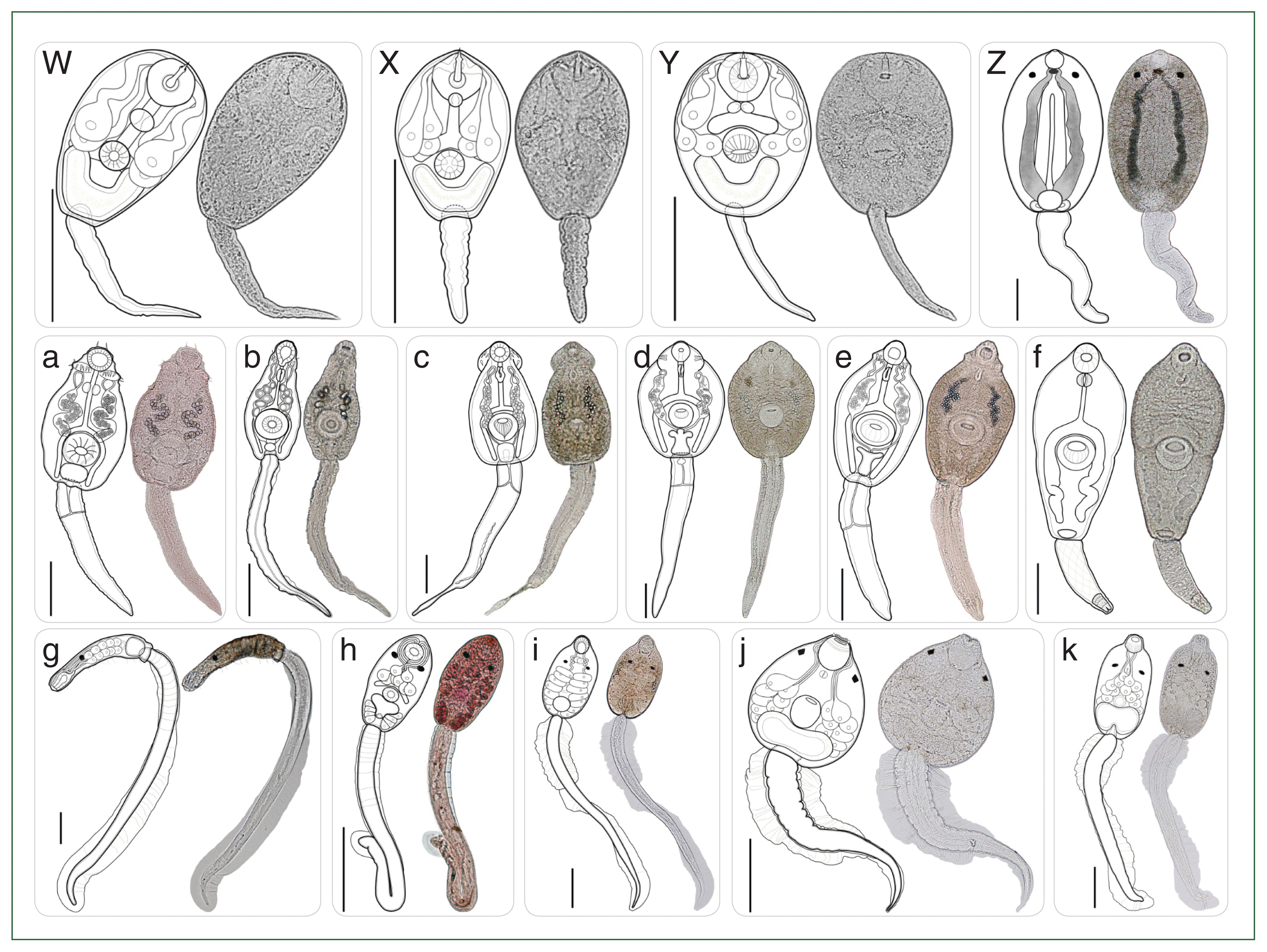1. Schell SC. How to know the trematodes. Brown Company Publisher. Dubuque USA. 1970, p 354.
3. Paperna I, Dzikowski R. Digenea (Phylum Platyhelminthes). In Woo PTK ed, Fish Diseases and Disorders. Vol. 1: Protozoan and Metazoan Infections. CABI Publishing and the Natural History Museum. Wallingford, United Kingdom. 2006, pp 345-390.

5. Younis NA, Elgendy MY, El-Samannoudy SI, Abdelsalam M, Attia MM. Cyathocotylidae spp. and motile aeromonads co-infections in farmed Nile tilapia (
Oreochromis niloticus) causing mass mortality.
Microb Pathog 2023;174:105897
https://doi.org/10.1016/j.micpath.2022.105897


6. Krailas D, Namchote S, Komsuwan J, Wongpim T, Apiraksena K, et al. Cercarial dermatitis outbreak caused by ruminant parasite with intermediate snail host: schistosome in Chana, South Thailand.
Evol Syst 2022;6:151-173
https://doi.org/10.3897/evolsyst.6.87670

7. Agrawal MC. Prevalence in final host. In Agrawal MC ed, Schistosomes and Schistosomiasis in South Asia. Springer. New Delhi, India. 2012, pp 85-121.


8. Suwannatrai A, Saichua P, Haswell M. Epidemiology of
Opisthorchis viverrini infection. In Sripa B, Brindley PJ eds, Advances in Parasitology. Academic Press. USA. 2018, pp 41-67.


9. Anucherngchai S, Tejangkura T, Chontananarth T. Epidemiological situation and molecular identification of cercarial stage in freshwater snails in Chao-Phraya Basin, Central Thailand.
Asian Pac J Trop Biomed 2016;6(6):539-545
https://doi.org/10.1016/j.apjtb.2016.01.015

10. Chantima K, Suk-ueng K, Kampan M. Freshwater snail diversity in Mae Lao Agricultural Basin (Chiang Rai, Thailand) with a focus on larval trematode infections.
Korean J Parasitol 2018;56:247-257
https://doi.org/10.3347/kjp.2018.56.3.247



11. Chontananarth T, Tejangkura T, Wetchasart N, Chimburut C. Morphological characteristics and phylogenetic trends of trematode cercariae in freshwater snails from Nakhon Nayok Province, Thailand.
Korean J Parasitol 2017;55(1):47-54
https://doi.org/10.3347/kjp.2017.55.1.47



12. Krailas D, Namchote S, Koonchornboon T, Dechruksa W, Boonmekam D. Trematodes obtained from the thiarid freshwater snail
Melanoides tuberculata (Müller, 1774) as vector of human infections in Thailand.
Zoosyst Evol 2014;90(1):57-86
https://doi.org/10.3897/zse.90.7306

13. Veeravechsukij N, Namchote S, Neiber MT, Glaubrecht M, Krailas D. Exploring the evolutionary potential of parasites: larval stages of pathogen digenic trematodes in their thiarid snail host
Tarebia granifera in Thailand.
Zoosyst Evol 2018;94(2):425-460
https://doi.org/10.3897/zse.94.28793

14. Wiroonpan P, Chontananarth T, Purivirojkul W. Cercarial trematodes in freshwater snails from Bangkok, Thailand: prevalence, morphological and molecular studies and human parasite perspective.
Parasitology 2021;148(3):366-383
https://doi.org/10.1017/S0031182020002073



15. Kiatsopit N, Sithithaworn P, Kopolrat K, Namsanor J, Andrews RH, et al. Trematode diversity in the freshwater snail
Bithynia siamensis goniomphalos sensu lato from Thailand and Lao PDR.
J Helminthol 2016;90(3):312-320
https://doi.org/10.1017/S0022149X15000292


16. Kulsantiwong J, Prasopdee S, Piratae S, Khampoosa P, Thammasiri C, et al. Trematode infection of freshwater snails, family Bithyniidae in Thailand.
Southeast Asian J Trop Med Public Health 2015;46(3):396-405.

17. Harkins B. Thailand Migration Report 2019. United Nations Thematic Working Group on Migration in Thailand. Bangkok, Thailand. 2019, p 194.
18. Molle F. The closure of the Chao Phraya River Basin in Thailand: its causes, consequences and policy implications. In Shivakoti GP, Vermillion DL, Lam WF, Ostrom E, Pradhan U, et al eds, Asian Irrigation in Transition: Responding to the Challenges Ahead. 2002, April. 22–23. Asian Institute of Technology. Bangkok, Thailand. Sage Publications. New Delhi, India. 2002, pp 1-15.
20. Daniels RA. Untested assumptions: the role of canals in the dispersal of sea lamprey, alewife, and other fishes in the eastern United States.
Environ Biol Fishes 2001;60(4):309-329
https://doi.org/10.1023/A:1011032907484

21. Kaewkes W, Kaewkes S, Tesana S, Laha T, Sripa B. Fecal bacterial contamination in natural water reservoirs as an indicator of seasonal infection by
Opisthorchis viverrini in snail intermediate hosts.
Parasitol Int 2012;61(1):49-51
https://doi.org/10.1016/j.parint.2011.08.013


23. Brandt RAM. The non-marine aquatic Mollusca of Thailand. Archiv für Molluskenkunde 1974;105(1–5):1-423.
24. Upatham ES, Sormani S, Kitikoon V, Lohachit C, Burch JB. Identification key for the fresh and brackish-water snails of Thailand. Malacol Rev 1983;16:107-132.
25. Wykoff DE, Harinasuta C, Juttijudata P, Winn MM.
Opisthorchis viverrini in Thailand: the life cycle and comparison with
O. felineus.
J Parasitol 1965;51(2):207-214
https://doi.org/10.2307/3276083


26. Bush AO, Lafferty KD, Lotz JM, Shostak AW. Parasitology meets ecology on its own terms: Margolis et al. revisited.
J Parasitol 1997;83(4):575-583
https://doi.org/10.2307/3284227


28. Carstensen B, Plummer M, Laara E, Hills M. Epi: A Package for Statistical Analysis in Epidemiology [Software]. 2.48. The Comprehensive R Archive Network (CRAN): Bendix Carstensen; 20241 package: Extensions to the R statistical programming language.
32. Karra K, Kontgis C, Statman-Weil Z, Mazzariello JC, Mathis M, et al. Global Land Use/Land cover with Sentinel 2 and Deep Learning. 2021 IEEE International Geoscience and Remote Sensing Symposium IGARSS. 2021 Jul 11–16; Brussels, Belgium: IEEE; 2021. 8707
https://doi.org/10.1109/IGARSS47720.2021.9553499

34. Chai JY. Human Intestinal Flukes: from Discovery to Treatment and Control. Springer. Dordrecht, Netherlands. 2019, p 549.
36. Gordy MA, Koprivnikar J, McPhail B, Hanington PC. Environmental and ecological factors driving trematode parasite community assembly in central Alberta lakes.
Int J Parasitol Parasites Wildl 2020;13:283-291
https://doi.org/10.1016/j.ijppaw.2020.11.008



38. Cremonte F, Gilardoni C, Pina S, Rodrigues P, Ituarte C. Revision of the family Gymnophallidae Odhner, 1905 (Digenea) based on morphological and molecular data.
Parasitol Int 2015;64(2):202-210
https://doi.org/10.1016/j.parint.2014.12.003


40. Brockelman WY, Upatham ES, Viyanant V, Ardsungnoen S, Chantanawat R. Field studies on the transmission of the human liver fluke,
Opisthorchis viverrini, in northeast Thailand: population changes of the snail intermediate host.
Int J Parasitol 1986;16(5):545-552
https://doi.org/10.1016/0020-7519(86)90091-3







